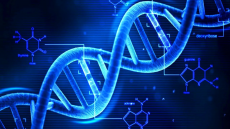

There are three stages of transcription, initiation, elongation and termination. Initiation is when RNA polymerase holoenzyme binds the promoter, opens the DNA double helix and starts to transcribe. The promoter must be recognisable in order for RNA polymerase to bind. There is an in vitro method to work out what the promoter looks like. In this method, RNA polymerase holoenzyme binds to DNA. This will then lock onto the promoter. We then add nuclease; the DNA is then degraded except for the stretch that is bound to RNA polymerase (as it is protected.) Where DNA is bound to a protein, it is protected from enzymatic cleavage, thus where RNA polymerase (a protein) is bound to DNA, we can work out where on the sequence the protein binding site is. Usually, the two regions that are protected are around -10bp (-10 sequence) from the start of transcription and -35bp (-35 sequence) from the start of transcription (+1.) +1 is usually adenine or guanine. Different promoters operate at different strengths, stronger promoter sequences are closer to the consensus. The asymmetry of the promoter sequences provide directionality. The -10 and -35 consensus sequences are defined on the sense strand. RNA is built in the 5’ to 3’ direction where new nucleotides are added at the 3’ end using the antisense strand as a template.
A sigma subunit binds to the core polymerase and directs the polymerase holoenzyme to a promoter, binding to the -10 and -35 regions. The DNA double helix is opened up at the -10 regions by RNA polymerase converting the closed promoter complex into the open promoter complex. Opening a helix tightens downstream and loosens upstream. Topoisomerases regulate transcription. 12 to 15bp are unwound, from within the -10 region to position +2 or +3, this exposes the transcriptional start site. RNA polymerase can now make an RNA copy from the antisense strand. Next elongation begins.
After roughly 10 nucleotides of RNA synthesis, the sigma subunit is exposed leading to elongation. Elongation is when the sigma subunit disengages from the holoenzyme and the core enzyme continues to make new RNA. Termination is when RNA polymerase core enzyme dissociates from the DNA and transcription halts. There are two methods of termination. One requires the protein Rho, meaning it is Rho-dependent whilst the other does not (Rho-independent). The functioning signals are recognised in the newly synthesised RNA and not the DNA template. Where Rho is not needed there is a terminator sequence in the RNA that is recognised. Whilst where there is rho, the rho binds to the cytosine-rich, guanine-poor sequence in RNA and uses its helicase activity to chase RNA polymerase. Note that rho can move faster than RNA polymerase. Once it has reached RNA polymerase it disrupts the DNA:RNA hybrid, releasing the DNA.
Polymerase binding causes DNA to bend, this opens up the helix. You can see this for yourself if you find a spring, and bend it, you will see the wires in the centre are spread apart and further exposed. This is why no ATP is needed for transcription to occur. Rifampicin is an inhibitor of prokaryotic transcription. It inhibits RNA polymerase by binding tightly to the RNA exit channel, therefore affecting initiation.
Image Credits:
https://www.google.co.uk/search?hl=en&biw=1082&bih=696&tbm=isch&sa=1&ei=Uy4HWpfrCeqBgAamlJnADA&q=dna&oq=dna&gs_l=psy-ab.3..0j0i67k1l5j0j0i67k1l3.41975.42781.0.43214.3.3.0.0.0.0.58.155.3.3.0....0...1.1.64.psy-ab..0.3.154....0.gun9RTTcpSU#imgrc=V_VukwzFIicWhM:

0 Comment:
Be the first one to comment on this article.